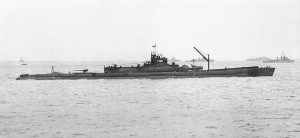The Hunt for Red October is based on a true story. What if there was an even bigger story out there involving submarines; that is 100% true and would’ve altered the course of the world had things not happened? Imagine a super submarine, capable of carrying aircraft and that is a game changer. That is exactly what the Japanese built and had deployed just before WWII ended.
These were the largest submarines every built, could carry 3 airplanes and stay out at sea for weeks at a time. A submarine that could carry an airplane seems like the stuff of legend. Where would it fit, how would the wings fold up and just how big would the submarine carrying it have to be?
The I-Series of submarines were being built by the Japanese during WWII. The I-400 was the class that was sent out to various targets just as WWII was ending. The description of when an American ship first sights an I-400 is how Operation Storm starts out and the book only gets better from there.
It’s a cliffhanger that happens very early in the book as someone on deck sees a submarine in the distance, on the water and bigger than any ship he’s ever seen. What’s great about the book is that the perspective switches with ease and grace from the Americans to the Japanese such that you never get confused. It’s a bit of a split screen effect, except that you want to read as quickly as possible to see what happens.
Of course, you know what happened ultimately, but that outcome was not guaranteed. Operation Storm is written by John Geoghegan and he carefully tells the story from all sides in this well documented book that looks at this fascinating and little known aspect of WWII in detail. The 400 series submarines were featured on PBS but this was our first introduction to this forgotten page of history.
The submarines held 3 Aichi M6A Serians in their belly. These were specially created airplanes that could land from the submarine and then return to the water surrounding the craft.
In the final days of WWII the I-400’s were out on a series of missions, one of which was to attack the Panama Canal. As Japan surrendered they sent word out to the submarines to return and not resist any attempts should they encounter American ships.
One of the 400’s went rogue. How did the American officers assigned with getting her back do this without re-starting WWII?
Operation Storm is a great book. You’ll keep reminding yourself that it’s real, because the stories are so incredible that you’ll think they’re fiction. Hundreds of interviews were done in researching the book and its attention to detail sparkles on every page.






 Facebook
Facebook Twitter
Twitter Flickr
Flickr GooglePlus
GooglePlus Youtube
Youtube
I had no idea those existed. Mind blown. Grandpa used to tell how they were on a transport ship as the war was ending, and a few Japanese planes would strafe the boat. He was in the pacific, and remembers the “pink, clang, pop” of the bullets ricocheting around them. I remember his words being something like, “Here the war is ending, and some idiot is still taking shots at us.”
And here I get nervous if I think some idiot is going to cut me off to get on the freeway. Puts things into perspective.
Jason
The Cheeky Daddy